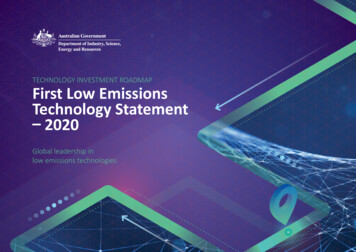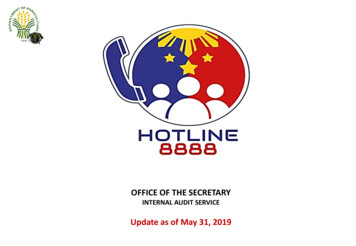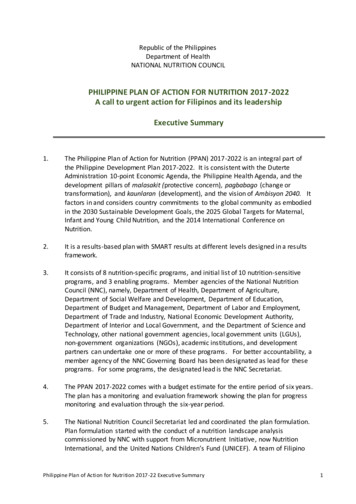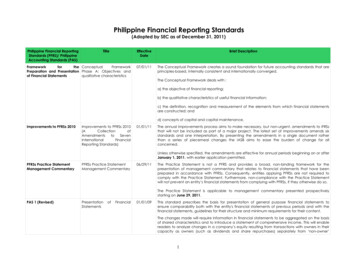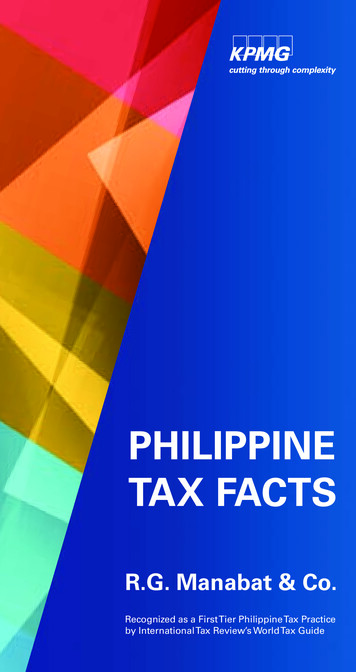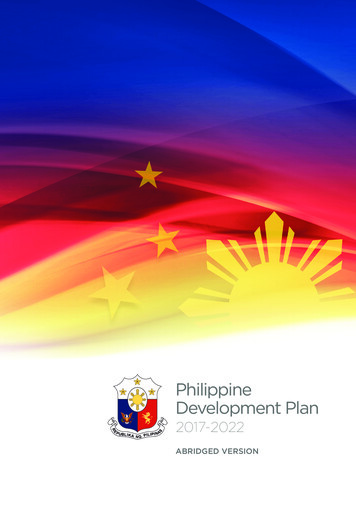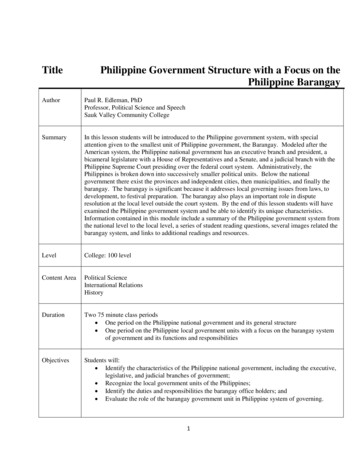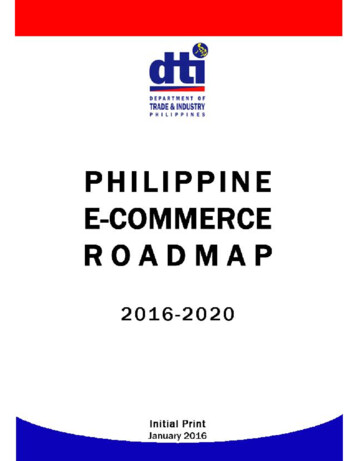
Transcription
1
Philippine E-Commerce Roadmap2016-2020Prepared by theSector Planning Bureau/E-Commerce OfficeDepartment of Trade and Industry
ACKNOWLEDGMENTSThe Department of Trade and Industry (DTI) wishes to express its heartfelt thanks to:Honorable Paolo Benigno “Bam” A. Aquino IV, Senator of the Philippines and Chairman ofthe Senate Committee on Trade, Commerce and Entrepreneurship, who inspired us in thedevelopment of the first e-commerce roadmap;Ms. Janette C. Toral, Owner, DigitalFilipino.com, who generously shared her time,knowledge and passion as consultant;The numerous stakeholders and partners from the private sector, industry and academe;andColleagues from other government agencies.We are extremely grateful to all of you for helping DTI put flesh into the roadmap byproviding your expert views, inputs and insights.We look forward to your continued commitment and support as we implement thePhilippine E-Commerce Roadmap 2016-2020.
EXECUTIVE SUMMARYThe Philippine E-Commerce Roadmap highlights the important role of e-commerce ineconomic development and presents the trends in e-commerce development globally,within the Asia-Pacific region, and within ASEAN. It likewise presents the state ofe-commerce adoption in the Philippines vis-a-vis other countries. The comparative datapresented imply that the Philippines is missing out on a lot of opportunities brought aboutby e-commerce. While a lot of opportunities exists, there are challenges that the countrystill has to face to be able to maximize the benefits of e-commerce.The Philippine E-Commerce Roadmap 2016-2020 addresses a number of issues in thee-commerce ecosystem that requires collective effort of the various stakeholders towardsthe realization of the goals outlined in the roadmap.The recommendations in this roadmap have been classified according to the six (6) I’s or thekey areas highlighted in the APEC Digital Prosperity Checklist. These key areas are asfollows:1. Infrastructure: The need for an appropriate supply chain, communications, andapplications infrastructure;2. Investment: The ability to promote and support a range of investment opportunitiesfrom Foreign Direct Investments to capital flows;3. Innovation: The ability to foster and support innovation, including the ability to protectinnovation and investment in research and development;4. Intellectual Capital: The ability to foster the appropriate skills and training fromtechnological to linguistic to entrepreneurship;5. Information Flows: The ability to use, transfer, and process information – the currencyof the digital economy – while promoting privacy and a trusted Internet environment;and6. Integration: The ability to connect domestic industries with the global economy.The need for appropriate infrastructure is critical in order to promote the widespreadadoption of e-commerce in the country. A fast, reliable, and affordable internet service thatis accessible by citizens even in the rural areas is a basic requirement that governmentneeds to address. The section on infrastructure also includes recommendations concerningsystems and applications that support e-commerce such as e-banking, e-payment, logistics,including the provision of an Online Dispute Resolution system to address consumercomplaints. It highlights the need to address the tax system to make it easier for onlinesellers and freelancers to comply with the tax regulations of the government. Moregovernment agencies should be able to provide full online services to the business sectorand the citizens.A number of big e-commerce players from other countries have been inquiring on how theycan do business here in the Philippines. Different regulations may apply for specific types ofe-commerce businesses. There may be a need to amend existing legislations andregulations to attract more investments in e-commerce.
Filipinos are known for their innovative ideas and the section on innovation deals mostlywith digital startups. It is important to nurture these digital startups from the developmentstage up to the point when their innovations will become commercially viable and rolled-outwithin the country.To foster the growth of e-commerce, information should be allowed to flow freely withinand across borders. Both the government and the private sector must ensure thatinformation, particularly personal information, must not be compromised.E-commerce enables domestic industries and enterprises to integrate into global valuechains and to directly access the global market. E-commerce is an equalizer as it will enableeven micro, small and medium enterprises (MSMEs) to directly penetrate the global market.The Philippine E-Commerce Roadmap 2016-2020 is not a standalone roadmap as it will besupported by other major initiatives of the government such as: the formulation of theNational Broadband Plan led by the ICT Office under the Department of Science andTechnology, and the National Retail Payment System project led by the Bangko Sentral ngPilipinas. In turn, it will support other initiatives such as the implementation ofiGovPhilippines, the Philippine Roadmap for Digital Startups, and the APEC Boracay ActionAgenda to Globalize MSMEs.
TABLE OF CONTENTSPageNo.MessagesAcknowledgmentsExecutive Summary . . .CHAPTER 1CHAPTER 2Introduction .Global and Regional Perspectives: Trends, Goals, and Targets .A. Global Perspective .B. Asia-Pacific Perspective .C. ASEAN Perspective .13345CHAPTER 3Philippine Perspective . .A. E-Commerce Environment B. Background and Institutional Support .C. Industry Opportunities . .Philippine E-Commerce Roadmap 2016-2020 A. Objectives . . B. Action Plan . .1. Infrastructure .a. Internet Access . .b. E-Government . c. E-Banking . .d. E-Payment . e. Tax System . .f. Consumer Protection . .g. Logistics .2. Innovation . .3. Investment . 4. Information Flow . .a. Data Privacy . .b. Cybersecurity . .5. Intellectual Capital . .6. Integration . .88912141414141416161718192021212222222323C. Implementation and Monitoring.24Summary of Meetings and Consultations Conducted .List of Consultation Participants E-Commerce-Related Laws and Policies (2000-2015) 252631CHAPTER 4Annex AAnnex BAnnex C
List of TablesList of FiguresTable 1. B2C E-Commerce Sales Worldwide by Region, (values inbillion US )Source: E-Commerce Across Asia - Trends and Developments 2014 Asia Briefing, pg. 4PageNo.4Table 2. Most Preferred Form of Online Payment Method in AsiaPacificSource: Online Shopping in Asia-Pacific - Patterns, Trends and FutureGrowth MasterCard Worldwide, pg. 75Table 3. Status of E-Commerce Law Harmonization in ASEAN as ofMarch 2013Source: Review of E-commerce Legislation Harmonization in theAssociation of Southeast Asian Nations, pg. xi7Table 4. ASEAN Internet Status (4th Quarter 2014)15Figure 1. World’s Key Digital Statistical IndicatorsSource: We Are Social3Figure 2. ASEAN Average Internet Speed Index 2014Source: netspeeds-across-asean.html6Figure 3. The Philippines’ Key Digital Statistical IndicatorsSource: We Are Social8Figure 4. Industry Performance of IT-BPM (2006 – 2014)Source: Board of Investments9Figure 5. Framework for the Promotion of E-Commerce in thePhilippines11
CHAPTER 1: INTRODUCTIONE-commerce is increasingly being viewed as a great equalizer, offering boundlessopportunities and possibilities, without discrimination, in the digital economy.The need for a roadmap to guide the Philippines in developing e-commerce and harnessingthe opportunities that e-commerce brings was expressed by Senator Paolo Benigno “Bam”A. Aquino IV, Chairman of the Senate Committee on Trade, Commerce andEntrepreneurship, at the 27 August 2014 Senate hearing on the development of a nationalindustry strategy roadmap for e-commerce.Putting into motion the Senator’s call, the Department of Trade and Industry (DTI) organizedthe “Strategic Conversations on E-Commerce” on 15 December 2014 to launch theformulation of the first Philippine E-Commerce Roadmap to cover the succeeding years until2020.The development of the Philippine E-Commerce Roadmap 2016-2020 is similar to theroadmapping activity that the DTI has been undertaking with various stakeholders under theIndustry Development Project1 wherein stakeholders have become active and valuedpartners, whose inputs are integral in the development of sound, balanced, responsive andrelevant policies and programs to spur inclusive growth.DTI, with the help of Ms. Janette C. Toral, the “mother” of the Electronic Commerce Act anda staunch e-commerce advocate, conducted face-to-face and online consultations2 withstakeholders3 across the country.The roadmap highlights the important role of e-commerce in economic development andpresents the trends in e-commerce development globally, within the Asia-Pacific region, andwithin ASEAN. It presents the state of e-commerce adoption in the Philippines vis-a-visother countries. The comparative data presented imply that the Philippines is missing outon a lot of opportunities brought about by e-commerce. While a lot of opportunities exists,there are challenges that the country still has to face to be able to maximize the benefits ofe-commerce.The roadmap addresses a number of issues in the e-commerce ecosystem that requirescollective effort of the various stakeholders towards the realization of the goals outlined inthe roadmap. It sets the direction, lays down the strategies and plots the policy and industrysupport measures for e-commerce to further grow within the next six (6) years to contribute25% of the Philippines’ Gross Domestic Product (GDP) by 2020, from 10% of GDP in 2015based on the data generated by i-Metrics Asia Pacific Corporation.The recommendations in this roadmap have been classified according to the six (6) I’s or thekey areas highlighted in the APEC Digital Prosperity Checklist4: Infrastructure, Investment,Innovation, Intellectual Capital, Information Flows and Integration.1Formulated to revitalize and reinvigorate Philippine manufacturing under the Manufacturing Resurgence ProgramPlease refer to Annex A for the Summary of Meetings and Consultations Conducted3Please refer to Annex B for the List of Consultation Participants21 Page
The roadmap is not a standalone document. It will be supported and complemented byother major initiatives of the government such as: the formulation of the NationalBroadband Plan led by the Information and Communications Technology Office under theDepartment of Science and Technology, and the National Retail Payment System project ledby the Bangko Sentral ng Pilipinas. In turn, it will support other initiatives such as theimplementation of iGovPhilippines, the Philippine Roadmap for Digital Startups, and theAPEC Boracay Action Agenda to Globalize MSMEs.4Endorsed during the 2008 APEC Ministerial Meeting in Lima, Peru2 Page
CHAPTER 2: GLOBAL AND REGIONAL PERSPECTIVES:TRENDS, GOALS, AND TARGETSA. Global PerspectiveE-commerce has seen a rapid pace of growth worldwide in both developed and developingcountries. With increasing internet penetration and use of personal computers and mobiledevices, more and more consumers now have the opportunity to purchase goods and servicesthey want online. In terms of the projected sales for 2015, 5China remains the biggest ecommerce market (US 562.66B) followed by the United States of America (US 349.06B) andthe United Kingdom (US 93.89B).Figure 1. World’s Key Digital Statistical IndicatorsSource: We Are SocialIn a study conducted by Nielsen, non-consumable products such as clothing, airline ticket, hotelreservations and event tickets are the most prominent categories.6 For some products likeelectronic devices, sporting goods and even vehicles, consumers still prefer to purchase them ina brick-and-mortar setting rather than online since some of these products require physicalinspection and in-store trial. However, more consumers often use the internet to compareprices and technical specifications and read the reviews of other people before deciding whichspecific product to buy.The contribution of e-commerce to economic development is now widely recognized. It may befor this reason that recently concluded trade agreements and those that are currently on thenegotiating table have devoted a separate chapter on e-commerce. As countries push for cross-5– Keith, M. (2015, September 2). Global E-commerce Sales, Trends and Statistics 2015. Retrieved October 26, 2015, s-trends-and-statistics-20156– Nielsen Holdings N.V (2015, August). E-commerce - Evolution or Revolution in the Fast-Moving Consumer Goods World (August 2014).Retrieved October 26, 2015, from http://ir.nielsen.com/files/doc -2014.pdf3 Page
border e-commerce, discussions in international engagements are focused on the developmentof a harmonized legal framework for e-commerce.B. Asia-Pacific PerspectiveAsia-Pacific is expected to become the leading region for e-commerce sales globally in 2015,representing 33.4% of the total retail sales, compared with 31.7% in North America and 24.6%in Western Europe.7According to the International Telecommunications Union (ITU), more than 36.9% of individualsand 39% of households in the Asia-Pacific region have internet access in 2015 with a 42.3%mobile broadband penetration rate.8With the global spread of internet access to 40% of the world’s population9, e-commerce hasbrought new ways on how commodities and services are being purchased, sold and advertised.Business-to-consumer (B2C) e-commerce sales in the Asia-Pacific region broke the US 1 trillionmark in 2012. By the end of 2015, the Asia-Pacific region will become the largest regional ecommerce market in the world, with consumers projected to outspend their North Americancounterparts by US 40 billion and account for more than 45% of all online buyers worldwide.10Table 1. B2C E-Commerce Sales Worldwide by Region,(values in billion US )RegionAsia-PacificNorth AmericaWestern EuropeCentral &Eastern EuropeLatin AmericaMiddle Source: E-Commerce Across Asia - Trends and Developments 2014 - Asia Briefing, pg. 4Understanding consumer demographics and spending habits is quickly becoming the key toidentifying strategic growth markets. While reliable statistics on online shoppers in the AsiaPacific region are still limited, analysts suggest they closely resemble their European and NorthAmerican counterparts who come from the middle class and between the ages of 25 and 64.11Existing rules and regulations on the entry of foreign investments in e-commerce activities insome countries are considered as major deterrents to the expansion of e-commerce in theregion. Some of the most promising markets for foreign investment in e-commerce remain offlimits to foreign companies, such as in India. Some may even feature significant barriers to7– Demandware and Singapore (2015). Developing eCommerce Market Entry Strategies in Asia-Pacific – Advisory Report 2015. RetrievedOctober 26, 2015, from per MarketEntryAsia ENG.pdf8– International Telecommunication Union. (2015, May 1). ICT Facts and Figures. Retrieved October 26, 2015, ts/facts/ICTFactsFigures2015.pdf9– Retrieved from: – Asia Briefing/Dezan Shira& Associates (2014, May 9). E-commerce Across Asia: Trends and Developments 2014. Retrieved October 26,2015, from 11– Asia Briefing/Dezan Shira& Associates (2014, May 9). E-commerce Across Asia: Trends and Developments 2014. Retrieved October 26,2015, from 4 Page
market entry such as the requirement that companies establish a physical retail shop beforeestablishing an online store, as in China. Consideration of these limitations and barriers iscritical when evaluating opportunities for investment in e-commerce worldwide.12In terms of social media usage in the region, Facebook remains on top followed by Twitter.13Modes of payment still vary country by country in the region. In a study conducted byMasterCard, 53% of respondents voted that credit card is their most preferred mode ofpayment.14 However, credit card penetration remains low in some countries like Indonesia andThailand which primarily pay through cash.15Table 2. Most Preferred Form of Online Payment Method in Asia-PacificCountryAustraliaChinaHong edit Card522566607049634153Debit Card243520241728264627Electronic Transfers3327255879Others19754616248Source: Online Shopping in Asia-Pacific - Patterns, Trends and Future Growth MasterCard Worldwide, pg. 7C. ASEAN PerspectiveThough e-commerce remains underdeveloped in Southeast Asia, it saw continuous growthespecially in countries like Singapore, the Philippines, Malaysia and Indonesia. A study byMatthew Zito, Dezan Shira & Associates stated that: “Payment systems are by far the mostcommon impediment to e-commerce growth across all four markets, primarily owing tounderdeveloped credit and debit card use typical of Asia more widely. The next most prevalentobstacle is internet access, which may be broken down into basic access and internet speed.While the former is spreading to every corner of ASEAN via low-priced smartphones, the latterhas some catching up to do before the e-commerce market can reach its full potential. Thetimely removal of these obstacles will strongly determine the future of the industry inASEAN.”16With the significant increase in the purchasing power and the growth in gross domestic product(GDP) per capita in ASEAN since the late 1970s, income growth has remained strong since 2000,with average annual real gains of more than 5%. 17 The region had 199 million internet users12– Asia Briefing/DezanShira& Associates (2014, May 9). E-commerceAcross Asia: Trends and Developments 2014. Retrieved October 26,2015, from 13– Waggener Edstrom Communications (WE). (2014, February 5). Content Matters: The Impact of Brand Storytelling Online In 2014.Retrieved October 26, 2015, from torytelling-2014/14–Master Card Worldwide. (2008). Online Shopping in Asia/Pacific – Patterns, Trends and Future Growth. Retrieved October 26, 2015,from pdfs/2008/Asia Pacific Online Shop.pdf15– Ibid16– Asia Briefing/DezanShira& Associates (2014, May 9). E-commerceAcross Asia: Trends and Developments 2014. Retrieved October 26,2015, from 17– Vinayak HV, Thompson, F., &Tonby, O. (2014, May). Understanding ASEAN: Seven things you need to know. Retrieved October 26,2015, from http://www.mckinsey.com/insights/public sector/understanding asean seven things you need to know5 Page
(32% penetration) in 2014. This figure is expected to rise to 294 million (48% penetration)within three (3) years.18 The ASEAN is also leading the world in terms of social media use.19Despite the millions of users and increasing internet penetration, most people in the region stillprefer shopping in brick and mortar than online. Less than one of six consumers from the regionpurchase online20 which is due to the fact that shopping in malls has become part of the routineof consumers.Improvements on internet infrastructure should also be considered in order to maximize thepotential of e-commerce in Southeast Asia. The speed of internet in ASEAN is relatively lowcompared to other regions but is surprisingly more expensive. The Philippines lags behind otherASEAN countries in terms of internet speed with an average of 3.6 Mbps while Singapore has 61Mbps outspeeding even the USA (22.3 Mbps) and Japan (41.7 Mbps).Figure 2. ASEAN Average Internet Speed Index 2014Source: net-speeds-across-asean.htmlIn terms of laws and regulations, ASEAN countries have individual legislations governing ecommerce but there are no laws that oversee cross-border trading and other regional ecommerce activities. Harmonizing these individual laws will promote growth, competitivenessand safeguard the areas of e-transactions, consumer protection, data protection and privacy,cybercrime, content regulation, domain names and dispute resolution, as well as cloudcomputing policy.2118– UBS. (2014, June 13). ASEAN eCommerce - Is ASEAN at an inflection point for eCommerce? Retrieved October 26, 2015, -report-2014.pdf19– Overview of E-commerce in Southeast Asia. (2015, May 5). Retrieved October 26, 2015, from ast-asia/20– Olsen, G., Chua, S., Gergele, O., & Bartolucci, F. (2015). Lifting the Barriers to E-commerce in ASEAN. Retrieved October 26, 2015, 871/Lifting the Barriers to E-commerce in ASEAN.pdf/d977df60-3a86-42a6-8d191efd92010d5221– Review of E-commerce Legislation Harmonization in the Association of Southeast Asian Nations. (2013, August). Retrieved October 26,2015, from 013d1 en.pdf6 Page
Table 3. Status of E-Commerce Law Harmonization in ASEAN as of March laysiaMyanmarPhilippinesSingaporeThailandViet nactedEnactedEnactedEnactedEnactedProvisions insome e: Review of E-commerce Legislation Harmonization in the Association of Southeast Asian Nations, pg. xi7 Page
CHAPTER 3: PHILIPPINE PERSPECTIVEA. E-Commerce EnvironmentThe Philippines is currently estimated to have the fastest growing internet population in theworld, with recent statistics estimating 530% growth over the past five years. Close behind thePhilippines in global rankings are other Asian countries such as Indonesia in second place with430% growth over the same period, India in fourth place at 230%, and Vietnam in seventh with82% growth.22At US 1.15 billion in 201323, the e-commerce industry is projected to increase at a compoundannual growth rate of 101.4% during 2013 to 2018. The B2C e-commerce market is projected togrow at 107.4% during the same period.24The Philippines, considering its sizeable youthpopulation and a slightly smaller population in the working-age range, is thus well-placed to seean increase in online retail in the near future.In a study conducted by VISA, nine (9) out of 10 Filipino consumers go online to shop at leastonce a month.25As in other Asian countries, Filipinos still prefer going to malls as it has becomea part of their culture.A survey conducted by We Are Social found that Filipinos spend an average of 6.3 hours everyday using the internet. Amazingly, the mobile subscription of the Philippines exceeded its 101.1million population by 13.5 million.Figure 3. The Philippines’ Key Digital Statistical IndicatorsSource: We Are Social22– Asia Briefing/DezanShira& Associates (2014, May 9). E-commerceAcross Asia: Trends and Developments 2014. Retrieved October 26,2015, from 23–Demandware and Singapore (2015). Developing eCommerce Market Entry Strategies in Asia-Pacific – Advisory Report 2015. RetrievedOctober 26, 2015, from per MarketEntryAsia ENG.pdf24–The Philippines E-commerce Market Outlook to 2018 - Driven by Rising Internet Proliferation and Effective Online Payment System.(2014, November 5). Retrieved October 26, 2015, from the-philippines-Ecommerce-market-outlook-to-2018# 25–VISA E-commerce Consumer Monitor 20148 Page
B. Background and Institutional SupportThe Electronic Commerce Act (ECA) or Republic Act No. 8792 was signed into law on 14 June2000 by President Joseph Ejercito Estrada. The law gave legal recognition to electronic formsof data messages, documents, signatures, transactions, storage of information. It providedpenalties for access of data without consent, piracy, hacking, and other violation. Provisionson DTI’s authority, under Section 29 of R.A. 8792, gave the DTI the authority to direct andsupervise the promotion and development of e-commerce in the country with relevantgovernment agencies.The law was instrumental, in addition to other policies, in driving investments into thebusiness process outsourcing (BPO) sector. At that time, these investments were referred toas e-commerce back-office operations. It is known today as the Information TechnologyBusiness Process Management (IT-BPM) sector, which recorded US 18.1 billion revenues in2014.Figure 4. Industry Performance of IT-BPM (2006 – 00620072008200920102011201220132014Revenue (US Billion)3.44.56.17.18.91113.216.118.9YoY Growth45%32%36%16%25%24%19%22%17%0%Source: Board of InvestmentsInformation Technology and Electronic Commerce Council (ITECC)On 12 July 2000, the Information Technology and Electronic Commerce Council (ITECC) wasformed through Executive Order No. 264 - “Establishing the Information Technology and Ecommerce Council (ITECC) from the merger of the National Information Technology Council(NITC) and the Electronic Commerce Promotion Council (ECPC).” The ITECC was chaired by DTISecretary Manuel A. Roxas II and Jaime Augusto Zobel De Ayala, as the private sector co-chair.The day after, 13 July 2000, the ECA’s Implementing Rules and Regulations (IRR) were issued.In 2001, ITECC was restructured through the issuance on 25 May 2001 of Executive Order No.18 - “Amending Certain Portions of Executive Order No. 264, Series of 2000.” President GloriaMacapagal-Arroyo became the Chairperson with DTI Secretary Roxas and Presidential Adviseron International Competitiveness Ambassador Roberto R. Romulo as co-chairs for thegovernment and the private sector, respectively.9 PageEmployment ('000)Revenue (in USD billion)IT-BPM Industry Performance20
ITECC committees were formed to address issues and gaps, help drive investments into theICT outsourcing sector, and move towards e-government implementation as mandated underthe E-Commerce Law. These committees were the Business Development Committee, eGovernment Implementation Committee, Information Infrastructure Committee, HumanResource Development Committee, and the Legal and Regulatory Committee, each of whichwas co-chaired by government and private sector representatives. Supporting ITECC and itscommittees was an auxiliary Communications Committee in charge of advocacy andinformation dissemination. Under ITECC, various offices/units of DTI and other governmentagencies actively participated as members of its committees.Various programs were undertaken by ITECC during this period. One of its biggestachievements was the creation of the E-Government Fund to support the implementationrequirements as indicated in the E-Commerce Law and other related policies. Specifically, it isa source of funding for strategic ICT projects of government that are mission-critical, highimpact and cross-agency in nature.ITECC was subsequently dissolved with the issuance on 20 July 2004 of Executive Order No.334, “Abolishing the Information Technology and Electronic Commerce Council andTransferring Its Budget, Assets, Personnel, Programs, and Projects to the Commission onInformation and Communications Technology.”Commission on Information and Communications Technology (CICT)The Commission on Information and Communication Technology (CICT) was created on 12June 2004 through Executive Order No. 269- “Creating the Commission on Information andCommunications Technology (CICT).” CICT, which was attached to the Office of the President,was the "primary policy, planning, coordinating, implementing, regulating, and administrativeentity of the executive branch of Government that will promote, develop, and regulateintegrated and strategic ICT systems and reliable and cost-efficient communication facilitiesand services." Section 4(n)
Source: E-Commerce Across Asia - Trends and Developments 2014 - Asia Briefing, pg. 4 4 Table 2. Most Preferred Form of Online Payment Method in Asia-Pacific Source: Online Shopping in Asia-Pacific - Patterns, Trends and Future Growth MasterCard Worldwide, pg. 7 5 Table 3. Status of E-Commerce Law Harmonization in ASEAN as of March 2013

